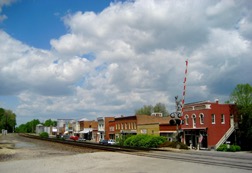Bridges To The Past And Future
August 2018

But I couldn’t take my eyes off the steel road for long, because this old bridge, like most of its sisters, requires nerve and skill and keen attention to avoid a sideswiping succession of 18-wheelers coming at us like they’re pumped from a pitching machine. Most of this bridge’s old river sisters have been replaced by wider, safer spans. Soon this ninety-year-old sister will retire, too.
From Washington, Highway 100 stretches toward Hermann like a clothesline, draping over bluffs and peeking down ravines at your road’s companion, the Missouri River. The river was the major highway when John Colter traveled upstream with Lewis and Clark. Later, Colter settled on a farm near what became New Haven. The town sits undisturbed by our plastic fast-food culture. Even mighty Amtrak doesn’t slow down as it splits the town in half, shaking windows with the blast of its fearsome whistlehorn when it barrels past.
The John Colter Memorial is the town’s centerpiece. Or maybe the centerpiece is the pair of museums, or the old Central Hotel Bed and Breakfast. But for me the town’s centerpiece is the art-deco ambiance of the Walt Theatre, an eighty-year-old movie house refurbished to its 1940s glory, with the original towering movie marquee dressed in neon. In a life-imitates-art moment, the marquee displayed one word: Sing. It’s an animated movie: “a Koala named Buster Moon has one final chance to restore his theatre to its former glory by producing the world’s greatest singing competition.”
Picking a sure bet for lunch, Erifnus parked in front of El Ranchito Mexican Restaurant, and I put another notch in my bandolier, maybe my 500th Mexican restaurant. Maybe more.
As we pulled out of the parking space and headed to the end of the street to cross the tracks, Amtrak’s Missouri River Runner bore down on the intersection. The crossing guard arm started to come down. I thought about trying to beat the train. Erifnus is old, and it wasn’t fair to turn her into scrap metal after a historic run. Worse, if we failed, the engineer and conductor and passengers would sustain injury from the impact and suffer post-traumatic distress. They would be delayed while emergency personnel cleared the wreck and packed my bloody body parts into a bag.
We waited for the train to pass, and we lost 20 seconds we’ll never get back.
John Robinson’s new book, “Souls Along The Road,” is available this fall.
